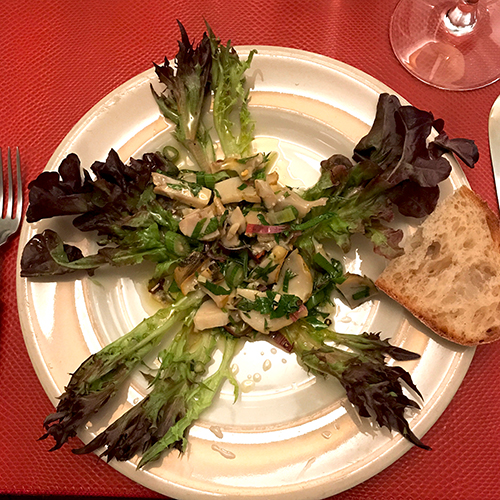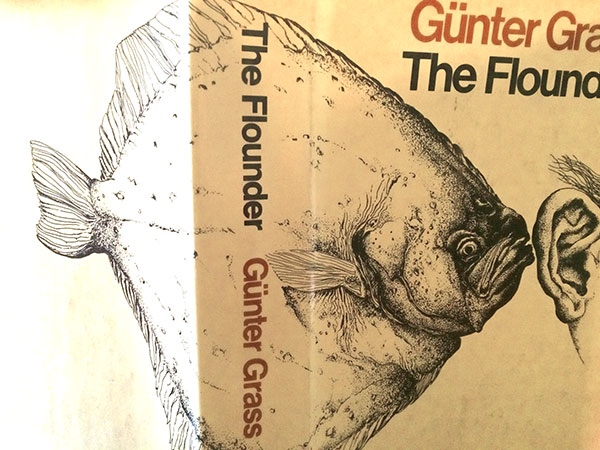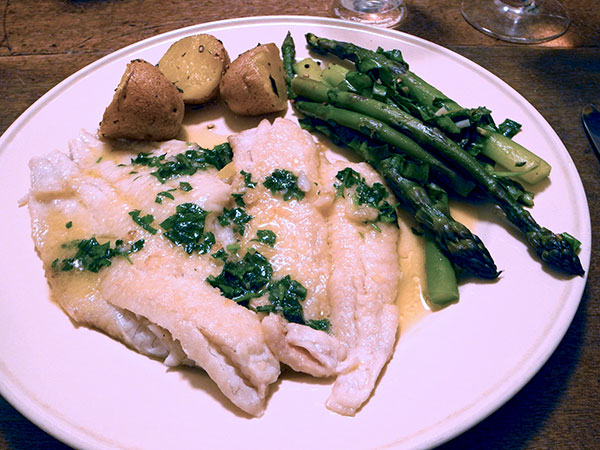
It was one of those times when I left the meal without a decent image of it. I still wanted to write something, so I decided to upload images of the 2 main ingredients that I might find on line, as a fallback, something I had occasionally done in the past. Then I learned that one of our guests had snapped a picture of the more unusual course, a whelk salad, and this is what you see above.
If the plate looks a little spare, it’s because it is a little spare. I now know that 12 ounces of raw whelks do not equal 12 ounces after they are cooked. Four days earlier I had assembled ingredients similar to the ones I used here, purchasing 5 ounces, enough for two servings, but using whelks already cooked. Yesterday I had started with 12 ounces, thinking that would be enough for 4, but unaware of the shrinkage that would give me far less than the equivalent serving of the mollusks after I had cooked them.
Next time I’ll be better prepared, and there will definitely be a next time; this is a great dish, and I’m going to want to find other ways to use a shellfish so under-appreciated in its own natural environment.
The main course was a dish I’ve prepared many times, although it never seem to look or taste the same. The recipe is a bit tricky when you have to cook enough for 4 people (especially if when I bring home a little more fish than I actually have to). I solved the immediate problem of the limited area of the largest enameled pan I had by cutting each half of the 2 fillets in half crosswise. It worked perfectly; it also made turning and transferring the delicate flounder much easier.
last night’s version of ‘flounder with tomato butter’ was as delicious as it was beautiful to look at: The fish was perfectly golden, and the mixed-size tomatoes were very colorful, giving me more reason to regret my failure behind the camera.
Still, there is compensation: I get to use this extraordinary 1978 Günther Grass etching, ‘Mann im Butt‘ (Man in Flounder), in lieu of some dumb photo. [cf. ‘sautéed flounder; asparagus, ramps; potato, savory‘]

The flounder wasn’t on its own: There were tomatoes.

The meal began with some Mario Fongo whole wheat and black rice grissini from Buon Italia.
- the wine with the breadsticks was a California (Sonoma) sparkling white, W. Donaldson Rose 2014, from Naked Wines
The first course was a conch salad.
- twelve ounces of raw channel whelks (3) from P.E. & D.D. Seafood (a mollusk which is described here), boiled slowly in unsalted water for 2 hours (I’m not convinced they had to be cooked that long, but that’s what I was told), removed, drained, the 3 operculum removed, cooled, sliced thinly, mixed in a bowl with some finely-sliced fresh spring shallots from Alewife Farm, minced garlic from Norwich Meadows Farm, crushed dried pepperoncino Calabresi secchi from Buon Italia, olive oil, juice from an organic lemon from Whole Foods Market, a bit of Columela Rioja 30 Year Reserva sherry vinegar, a few chopped stems of baby fennel bulbs from Alewife Farm, chopped mint and summer savory from Stokes Farm, chopped parsley from Norwich Meadows Farm, tarragon from Keith’s Farm, a bit of sea salt, and Freshly-ground Tellicherry pepper, the served on flat plates on top of leaves of two kinds of purple-leaf salad lettuce, a purple frizzy oak leaf lettuce from Norwich Meadows Farm and a bibb lettuce purple leaf lettuce from Eckerton Hill Farm, everything finished with a drizzle of olive oil
- accompanied by slices of a French-style organic whole wheat and whole spelt miche from Bread Alone in the Union Square Greenmarket
- the wine with the whelk salad was a beautiful French (Savoy) white, Philippe & Sylvain Ravier Vin de Savoie Les Abymes 2015, from Chelsea Wine Vault
The main course followed, after a decent interval determined entirely by the labors of the cook in the kitchen.
- two flounder fillets (totaling 25 ounces) from P.E. & D. D. Seafood, lightly seasoned, the halves of each each separated and each of those cut in half crosswise, making 8 pieces in all, cooked over high heat with the flesh side down for several minutes (4?) in a mixture of olive oil and butter inside a heavy enameled rectangular cast iron pan, turning once and continuing for another 2 minutes or so, arranged on the plates, a couple of spoonfuls of ‘tomato butter’ [see below] arranged mostly between the 2 sections of fish, finished with a garnish of micro nasturtiums leaves from Two Guys from Woodbridge
- tomato butter, begun by cooking one finely-chopped small fresh shallot from Alewife Farm inside a small pan with 3 or 4 tablespoons of melted butter until the shallot was slightly soft and fragrant, the flavored butter cool slightly before poured over 6 or 7 ounces of a mix in size and color of miniature tomatoes, some left whole, others cut in halves or thirds, adding 2 tablespoons of genoves basil from Windfall Farms, a few drops of good Spanish Rioja wine vinegar, the mix seasoned with salt, set aside and kept warm until ready to be arranged on the flounder
- a combination of green and yellow Romano beans from Norwich Meadows Farm, parboiled for a few minutes, drained, dried, reheated in olive oil (butter would be an alternative) inside a heavy tin-lined copper pan, tossed with chopped lovage from Central Valley Farm, seasoned with sea salt and freshly-chopped Tellicherry pepper, arranged on the plates and sprinkled with some chopped fronds from the baby fennel stems used with the salad
- the wine with the flounder was a California (Central Coast) white, Rick Boyer Coastal White Blend 2016, from Naked Wines
There was a dessert (no image)
- a good portion of a pint of gooseberries from Wilklow Orchards, gently heated in a small high-sided pot with a few drops of fresh water and a few tablespoons of turbinado sugar until the berries had softened and the sugar dissolved into their juices, spooned over scoops (one for each serving) of Lā Loos ‘Vanilla Snowflake’ goat milk ice cream from Whole Foods Market that had themselves been centered on the top of 2 slices a delicious ‘cream cheese pound cake’ from Wilklow Orchards, the farm which had also been the source of the berries
[the first image is from one of our guests; the second is from the de Young Museum/Legion of Honor]

